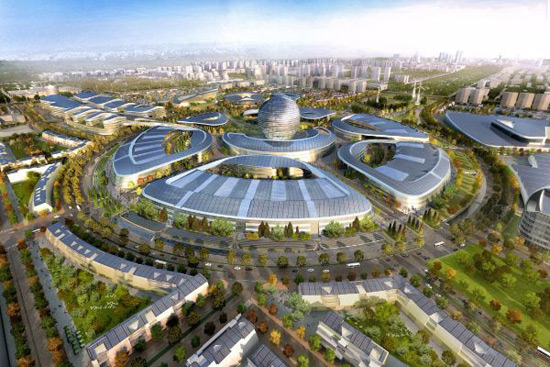The Expo 2017 global gathering will showcase developments from around the world in the field of green, renewable and sustainable energy. Expo 2017 will place Astana, Kazakhstan in the international spotlight for three months from June 10 to September 20, 2017. In order to welcome delegations from over 100 countries, and three to five million visitors, Astana is building Futuristic City incorporating renewable forms of energy. It will cost Kazakhstan $3 billion to $5 billion.

Futuristic City In Kazakhstan
Designed by Adrian Smith and Gordon Gill Architecture, Futuristic City will occupy about 429 hectares, and its main attraction will be the Kazakhstan Pavilion. In this building will be incorporated the glaze of high performance, which will make maximum use of solar heating in winter and provide pleasant shade in the summer.
From this central sphere will be provided twenty-eight buildings, including a science center, a theater with 1,000 seats, hotels, offices and residential spaces. Each building will include solar panels, while some will have solar windows. Also, in some buildings will be incorporated wind turbines, which will also be part of the parks. All buildings will be connected with smart grid, because in this way, each of them will have a role in the power supply of the entire city.

Futuristic City In Kazakhstan
When all this is added up, about 30 to 40 percent of the city will have renewable energy, while some buildings have energy efficiency of 75 percent, says Gil Gordon, one of the partners behind the project.
Although this project is primarily intended for the World Expo, the company behind the project designed the city so that it can be integrated with Astana, so that people can live and work in this area.
Astana Banking community chose International Pavilion as their favorite part and the new location after the end of World Expo, meaning that in the heart of this city will be the financial center, which will be surrounded by residential and hotel areas.

Futuristic City In Kazakhstan
Every detail of this design is well-considered, so that the city has its function after the fair. It was even suggested creating a space for sledding in the mountains that surround it, so that children can have fun during the colder days. Water that would result after melting snow would be re-used.
Futuristic City also has easy access to a nearby hospital, the airport and the university, and it is also planned the introduction of public transport lines during its later development.













